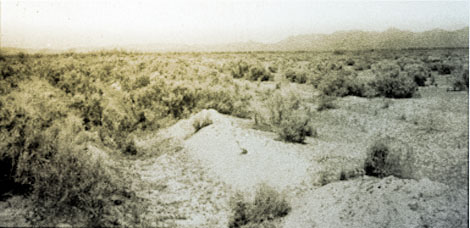

 Flooding on the Salt River created havoc for farmers as well as the Santa Fe Railroad. Floods damaged head gates, washed away diversion dams, and silted-in canals. Scenes like this ultimately led to the request for Federal assistance to build a dam on the Salt. 1905. (U.S. Reclamation Service)
Flooding on the Salt River created havoc for farmers as well as the Santa Fe Railroad. Floods damaged head gates, washed away diversion dams, and silted-in canals. Scenes like this ultimately led to the request for Federal assistance to build a dam on the Salt. 1905. (U.S. Reclamation Service) During the last three decades of the 19th century, increasing numbers of canals and ditches began snaking their way across the desert on both sides of the Salt River. Various canal and irrigation companies were formed to construct, manage and maintain the canals and ditches leading to peoples' farms, and insure one way or another that their rights to water were maintained. Lawsuits were common between individuals and canal companies, as well as between canal companies. Occasionally violence erupted over water rights. When the Arizona Canal was being built in the late 1880s, law suits were brought almost immediately against the Arizona Canal Company. Charles T. Hayden, who owned Hayden Flour Mill in Tempe, sued the Arizona Canal Company accusing it of taking the water needed to run his mill. Michael Wormser along with the Tempe Canal Company and the Utah Canal Company filed suit in late 1888 against the Arizona Canal Company as well as the Salt River Valley Canal, Maricopa Canal, Grand Canal, and Mesa Canal companies.
 Several miles east of Phoenix, formerly cultivated land has returned to desert. A lateral, visible in the foreground, lies useless because of a lack of water. Droughts, floods, and erratic river flows would plague Salt River Valley farmers until a dam was built to tame the river and some formal organization formed to promote equitable water management, 1902. ( Reclamation photograph)
Several miles east of Phoenix, formerly cultivated land has returned to desert. A lateral, visible in the foreground, lies useless because of a lack of water. Droughts, floods, and erratic river flows would plague Salt River Valley farmers until a dam was built to tame the river and some formal organization formed to promote equitable water management, 1902. ( Reclamation photograph) To make matters worse, river flow was erratic and made control and management of water all the more important. Periods of drought resulted in too little water for irrigation, while floods destroyed and washed out canals. The call for a dam on the Salt to control damaging floods and store water for periods of drought was a constant theme throughout the late 1800s. It soon became apparent that the cost for such a dam was prohibitive without federal support. The need to coordinate and manage water deliveries and distribution systems became more and more important as the 20th century approached. Through the insight and political savvy of several prominent Salt River Valley farmers and capitalists, the groundwork was laid for a just such an organization that was the key to the successful pursuit of a dam and better management of water in the Salt River Valley in the new century.
(Modified and adapted from: National Register of Historic Places Multiple Property Documentation Form, Salt River Project, Arizona, prepared by Jim Jim Bailey, Bureau of Reclamation, June, 2010.)
